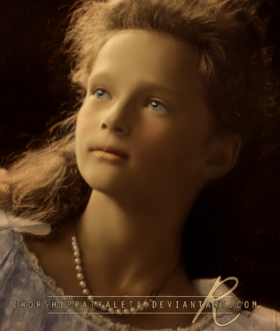-
Par Dona Rodrigue le 9 Juin 2014 à 18:54

Oh Yeah Baby! The Alexander Palace! Here I COME!
Since I didn’t get to go to the Alexander Palace on Friday (with my tour-group setting). I decided that I was going back on Sunday myself. My roommates Leah and Ross came with me (which is also great because their Russian language is awesome, and they always help me out when I get stuck). So together, we left the dorm at 9ish, and arrived at the train station around 10ish. It was a very interesting experience getting tickets for the train (let alone taking the train) because it was technically ‘Women’s Day’ (a national holiday) so a majority of the station was closed. We meandered around the station, and thankfully, found a ticket station for local trains. After fumbling through getting the tickets we walked out to the platform and got on the train. It was actually a cool experience in itself.
We arrived in Tsarskoe Selo/Pushkin just before noon. After getting off the train (the time to get off the trains at particular stations can actually be quite short – less than a minute – so you have to move fast).. Anyway… after we got off the train we took a local city bus to the Catherine Palace. We had a little brunch inside the Catherine Palace’s ‘buffet’ cafe (which was really small and disappointing actually). On our way out (towards the Alexander Palace) we passed by our friend we made on Friday
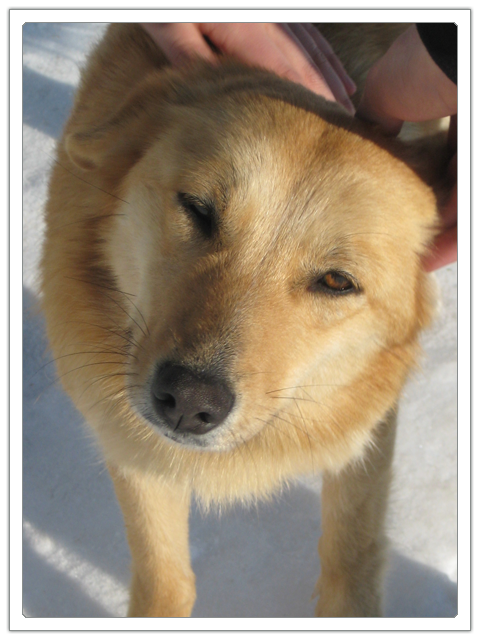
Now I must ask your forgiveness. The Alexander Palace is one of the Imperial residences that I am most interested in, and as such, I took hundreds of images. So please bare with me. I thinned the images I was going to post in half, and then in half again, there may still be too many photos, but I did try to thin them out.
That said… please let me introduce the Alexander Palace!
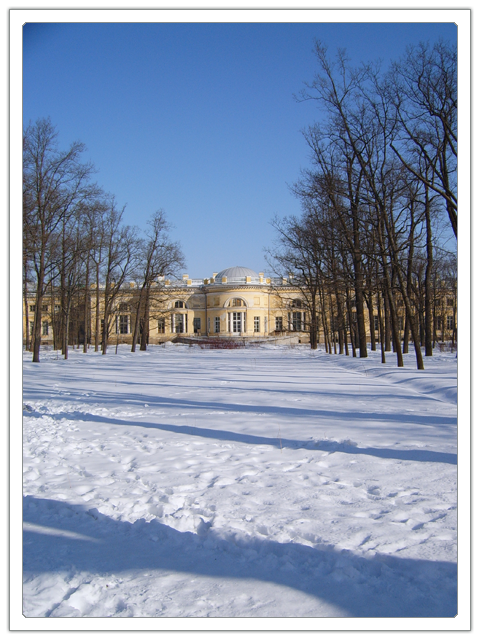
This is the back of the Alexander Palace. The Alexander Palace was built by Catherine the Great for her grandson Alexander I. Alexander I was the Tsar who defeated Napoleon, but this isn’t what interests me. What really interests me is the occupants of the Alexander Palace! From 1895 till 1917, this was the residence of Nicholas II and his Family (His wife Alexandra, his daughters, Olga, Tatiana, Maria, Anastasia and his son, the heir to the throne, Alexis)
Many of you fine folks know that Nicholas II and his Family is my ultimate Russian interest (which is why I ended up doing my History degree and taking Russian, and… eventually coming to Russia!) so getting to this palace was one of those life goals.I had written up a little history on the AP, but I have since found a lovely write up on the AP that I will include. For those interested, read on, for those not, just pass the huge block of text.
When Nicholas ascended the throne in 1894 he and his new wife Alexandra decided to make the Alexander Palace their principal residence. As a result, Nicholas II and his wife made the most significant changes to the building since the reign of Catherine the Great. Extensive renovations were made to the building and new systems, such as electricity, telephones, washing machines, elevators and flush toilets, were installed. One whole wing of the palace was completely redone in a strikingly domestic and luxurious way. Nicholas and Alexandra’s principal objectives were to create a comfortable and elegant family home.
Later changes to the palace in the reign of Nicholas II included the erection of the two finest Imperial Art Nouveau interiors in Russia and delightful rooms created for the Tsar’s children.
At the time of the Russian Revolution and the exile of the Romanov family to Siberia it was decided to convert the Tsar’s palace into a museum which documented the life of the Romanovs in the palace throughout the 19th century . Naturally, the strongest emphasis was placed on events in the reign of Nicholas II. Soon after the departure of the Romanovs for Tobolsk in August 1917 parts of the palace were opened to the public by it’s first curator, Lukomskii. After the murder of the Romanovs in Yekaterinburg in July 1918 some of their personal possessions that hand followed them to Siberia were returned.
The museum in the Alexander Palace showcased the interiors as closely as possible to their state in August 1917. They appeared as if the Tsar and his family had just left and might return at any moment. The tragedy of the story of the Romanovs and the intimacy of the private rooms created a lasting impression on those who saw them, creating sympathy for the Tsar and his family and this ran counter to the intentions of the Soviet Government. In 1919, soon after the Bolshevik coup, a part of the palace was converted into a Children’s Colony, but this experiment proved to be a disaster and these rooms were returned to the museum. Extensive restoration enabled these rooms to be reopened to the public. In the mid-1920′s Nicholas’ and Alexandra’s historic rooms in the Winter Place, which had been open as a part of the museum there, were closed and their furnishings disbursed. Some items were transferred to the rooms of the Alexander Palace where they were merged into the collection.
The Alexander Palace museum proved to be one of the most popular museums in Russia and was a must see for all foreigners who made it to the new Soviet state. Unfortunately, the government had an indifferent, even hostile attitude toward the “Romanov Museum”. Officials began to pilfer objects and furnishings from the palace for sale to foreigners and for the use of party officials. Later the secret police demanded the use of a part of the palace as their private resort. In order to prepare for this transition these rooms were emptied of their contents and the treasures sold off in stores for foreigners in Russia and by Hammer in the USA.
Throughout the 1930′s there were frequent threats by the government to close the rest of the museum and sell off its treasures. Somehow, the museum workers and public managed to dissuade the government from this step and the museum operated right up until the beginning of World War II.
At the outset of Hitler’s declaration of war on the Soviet Union in 1941 the Director of the Alexander Palace Museum, A. M. Kuchumov, received orders to evacuate around 300 objects from the path of advancing German troops. This was a tiny selection from a collection totalling tens of thousands of objects. Frantically, and with great courage and improvisation, the museum workers were able to pack and ship out of harm’s way a significant part of the museums’ collection. Sadly, thousands of precious treasures and items of extraordinary historical value were left behind.
When the Germans occupied the town they immediately looted the palaces. What they didn’t cart away for use in their military quarters was shipped off to Germany and Spain, where many of the palace treasures remain to this day. The palace itself was converted into an SS hospital and was heavily protected by German troops. An SS monument and graveyard decorated with Nazi symbols was erected in the palace courtyard.
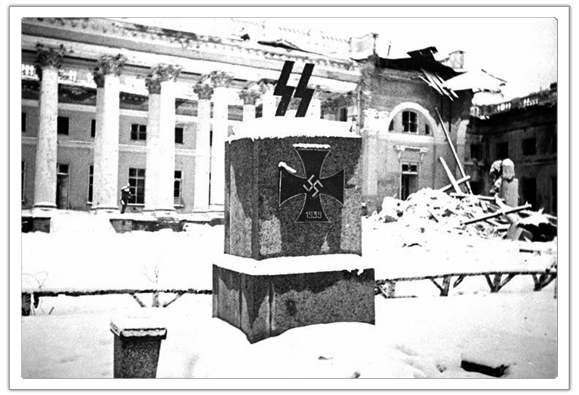
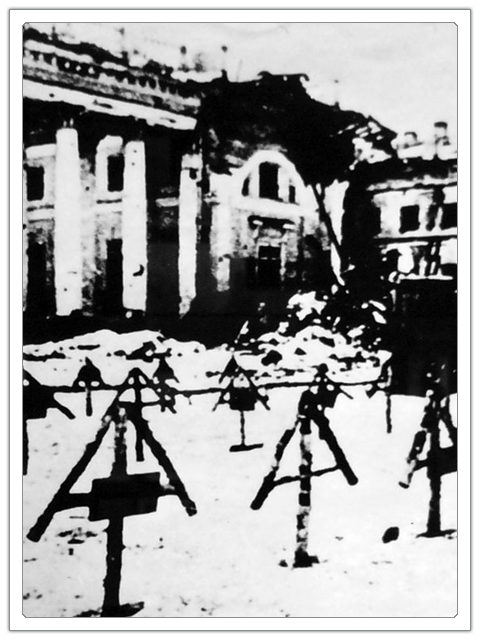
The palace was heavily damaged during the war by shell fire and reckless abuse by the Germans and their Spanish allies during their occupation.
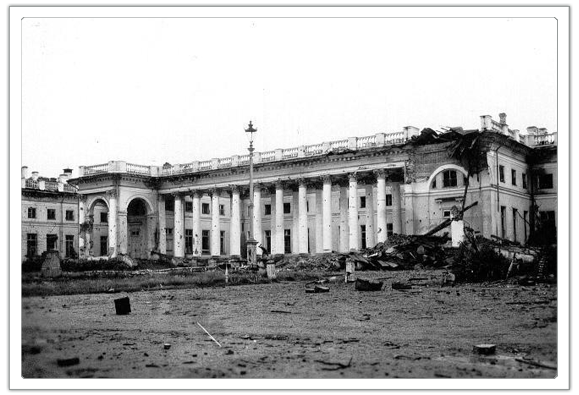
Still, considering the ordeal it had been through after the war the palace was discovered by returning museum workers to be in remarkable shape. It was the best preserved of all of the suburban palaces that had been behind German lines and was chosen to become the depot for works of art returning from Siberia to Leningrad. Ambitious plans were made for the restoration of the palace as it had been before the war. At this point the government, perhaps Stalin himself, made a critical decision about the future of the palace – it was not to be a Romanov museum. The palace was to be stripped and restored as a generic 19th century palace – any restoration that presented the private lives of the last Tsar and his family were forbidden. This restoration began and interiors which had survived the German occupation were brutally stripped and destroyed. Before this work was completed Stalin changed his mind and made another decision that the museum was to be closed altogether and the building presented to the Navy for their use. [Laura's Note - Half of the Alexander Palace is still occupied by the Russian Navy today -- Rumors that the Tsarskoe Selo Museum Fund recently bought it out do circulate though]
The invaluable and unique collection of the palace was dispersed among many museums. Pieces went to Pavlovsk, the Catherine Palace, the Hermitage and elsewhere. Most personal items associated with the last Tsar and his family were simply locked up and placed in indefinite storage. – Source
When I went this weekend, I noticed that there was more construction and scaffolding around the Palace. I can only hope that this means things are going to be taken care of for good, but one can only guess. Another rumor as to why the palace may be being restored is because next year (2010) is the Tercentenary of Tsarskoe Selo, so I imagine they’re going to want to spiff it up for the onslaught of tourists next year. (Hopefully me included) I have a shot taken a bit ago showing the current condition between the Navy’s side of the Alexander Palace, and the side that is currently used as a museum:
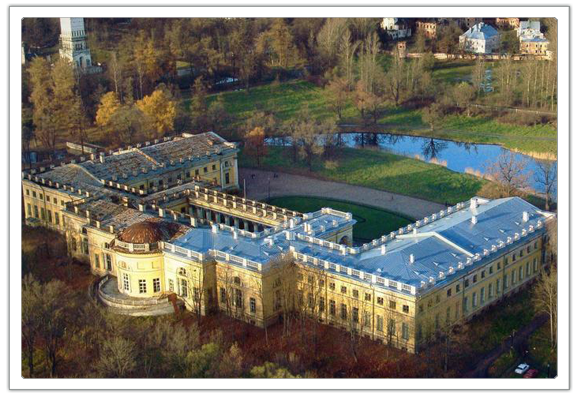
As you can see, there is some serious work needed on the other side.
Anyway, Here is the outside of the Alexander Palace from the front, taken this weekend: (And yes, for the parties interested, I have them available in much better resolution)
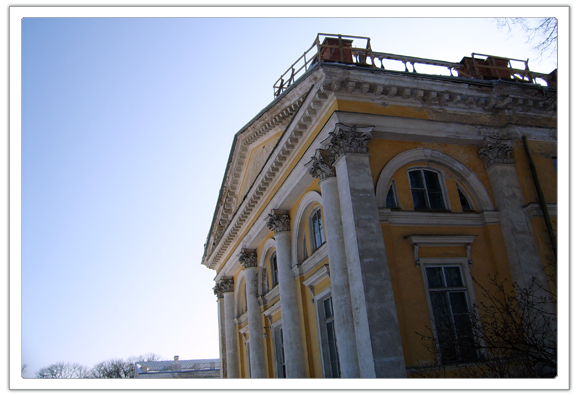
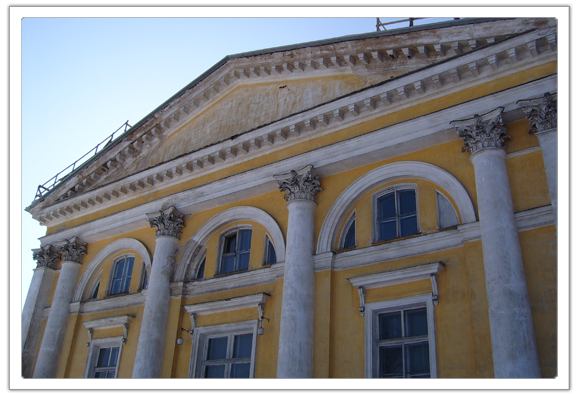
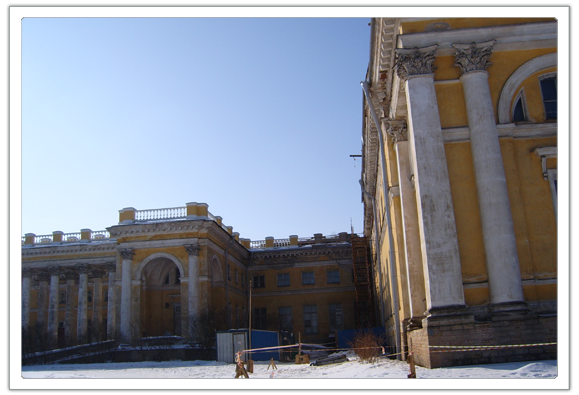
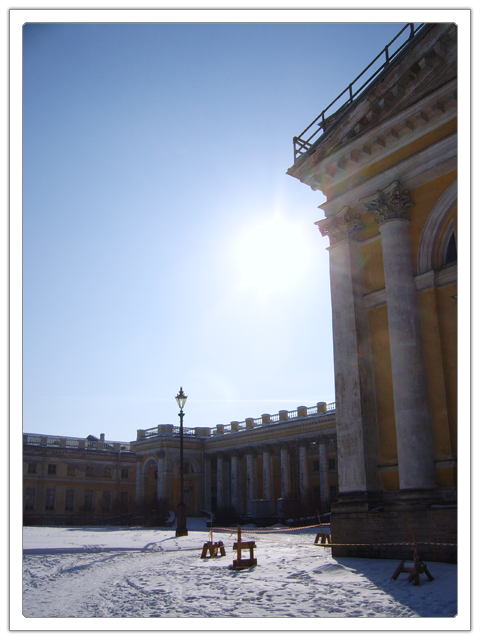

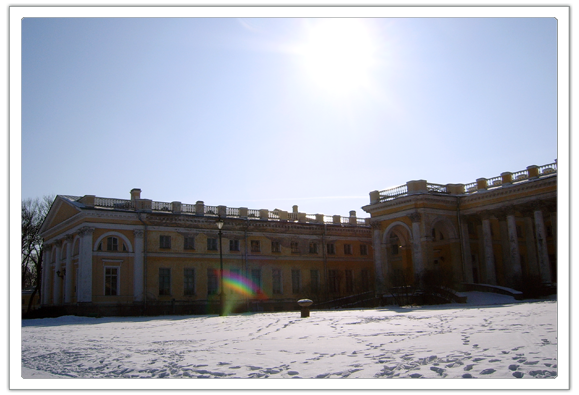
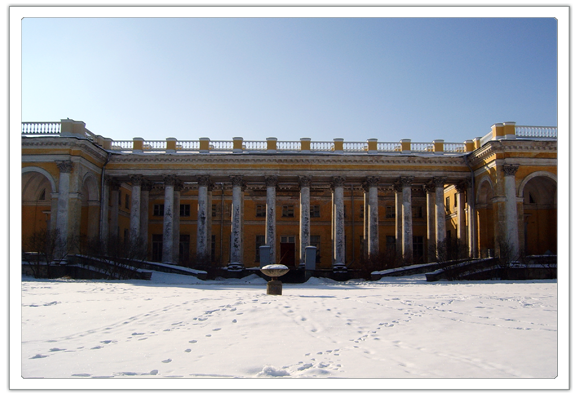

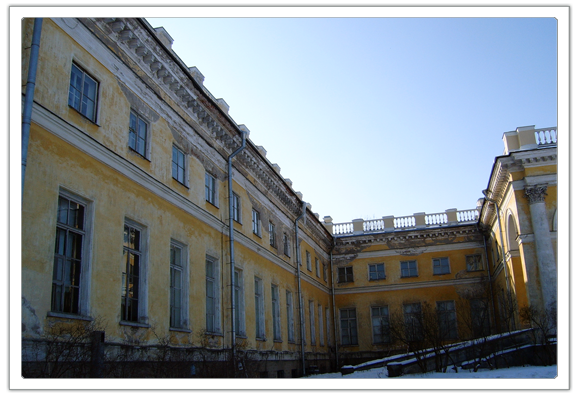
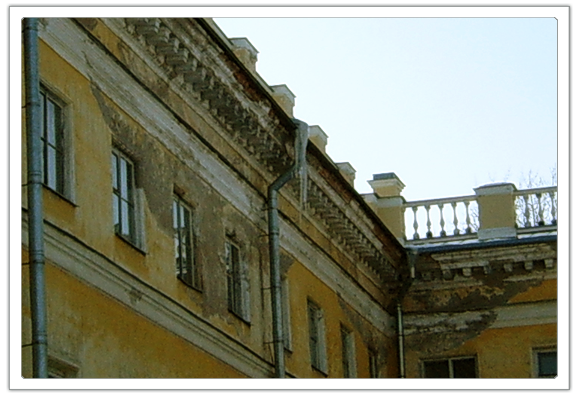
I zoomed in on the last one so you can see some of the damage still on the building.….
Yes! I did thin out the images, don’t give me that glare!
As you can see, it was an absolutely beautiful day at Tsarskoe. The sun was shining and the weather was pretty good, which also means there were quite a few people hanging around too.
A few years ago, they put up a plaque outside of the Alexander Palace commemorating the Imperial Family. Although some find it tacky, I thought it was nice, and took the opportunity to get a shot of me in front of it:
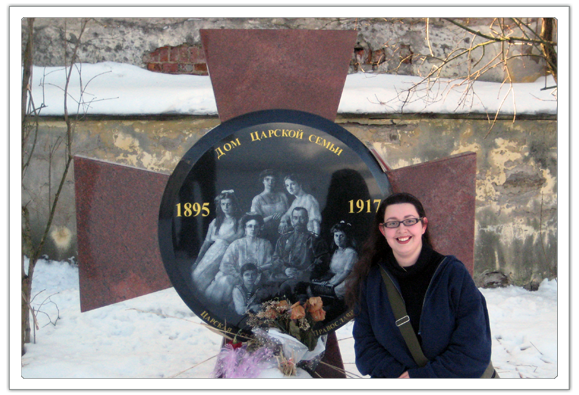
Ross, Leah and I went into the palace and got our tickets. (Student discount baby! Only 80 Roubles). They have a coat check in the basement (as well as the bathrooms) I tried to get photos of the basement but without flash nothing turned out. I will try again the next time I go.
Upstairs again, Leah, Ross and I tried to pass our tickets in to go see the Palace. They, however, saw that our tickets said ‘Russian Student’ and told us to wait for the Russian Tour Group that was going through momentarily. I am not sure if they were doing that out of kindness (giving us a free tour — because they thought we were fluent Russian citizens) or because they didn’t want three students meandering about the palace without a guide. Either way, since we got stuck with the guide group, I decided to stick to the back (mainly so I wouldn’t be rushed through, and so I could try to take shots of the Palace without 30 people in them).
The part of the Alexander Palace that is currently viewable, I’ll show on this map:
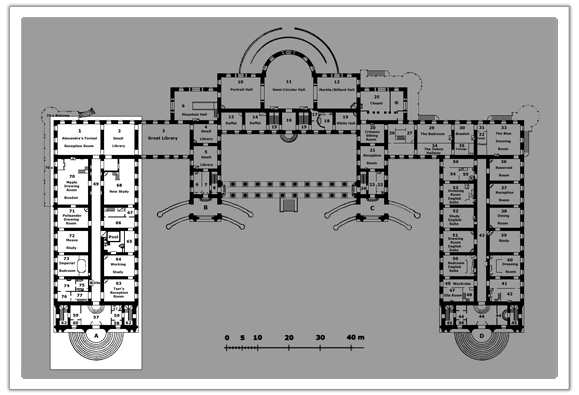
The tour itself follows these lines:
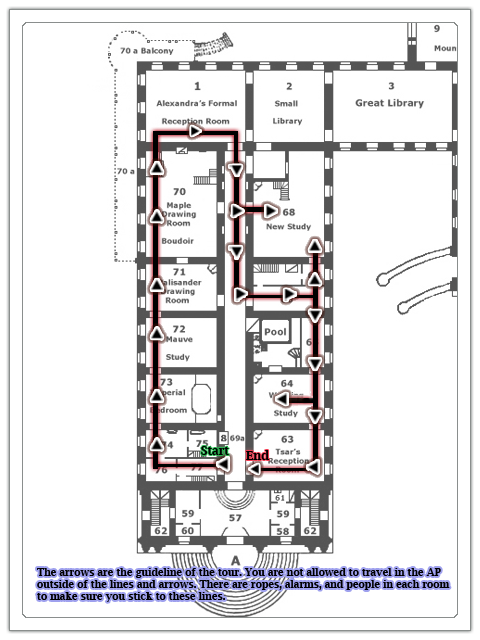
So with these floorplans in mind, I will show you the current interior (matched with the Romanov interior).
The Multi-Purpose Room
The first room we enter is rooms 74, 75, 76, and 77 on the Floorplan map. According to the floorplan, these rooms used to be:
74. The Dressing Room (of Alexandra)
75. The Bathroom
76. The Maid`s Room
77. The Wooden Staircase (to the mezzanine and to the second floor)However, it is all now one room. And a pretty empty room at that. Here it is in the current condition:
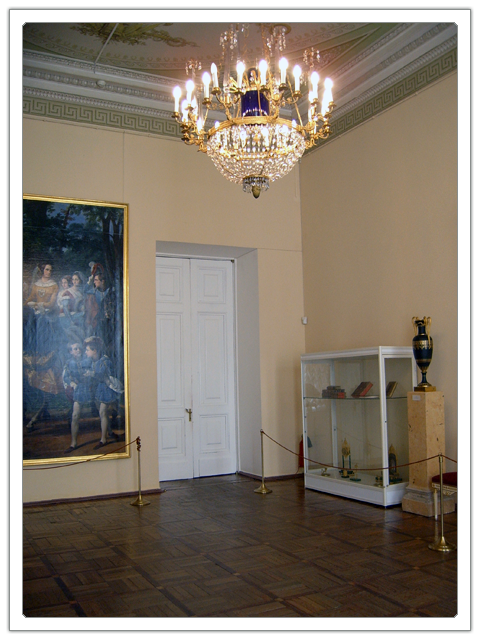
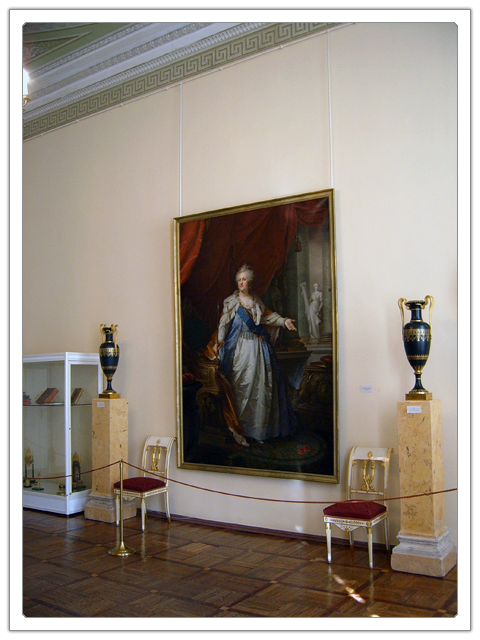
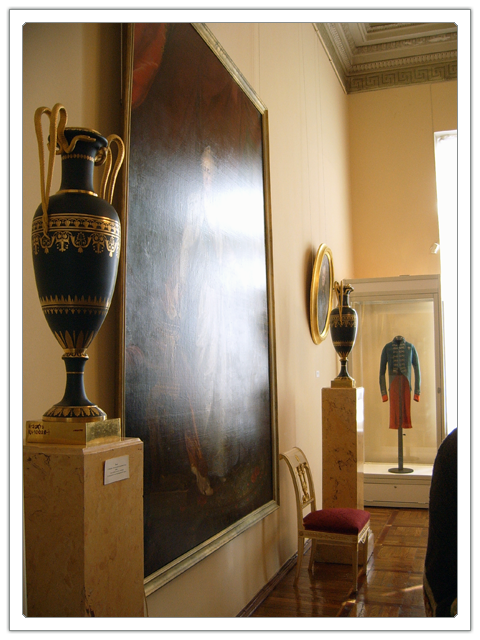
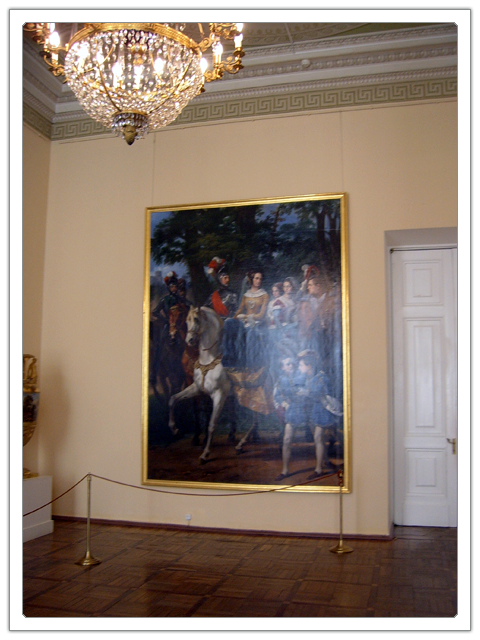
Here is a little video I got of the room:The Imperial Bedroom
The room right next to the multi-purpose room was Nicholas and Alexandra’s Imperial Bedroom. Before being completely demolished later in the soviet era, it used to look spectacular (although the tapestry pattern was a bit busy). Here is the Imperial Bedroom as it looked in the Romanov’s time: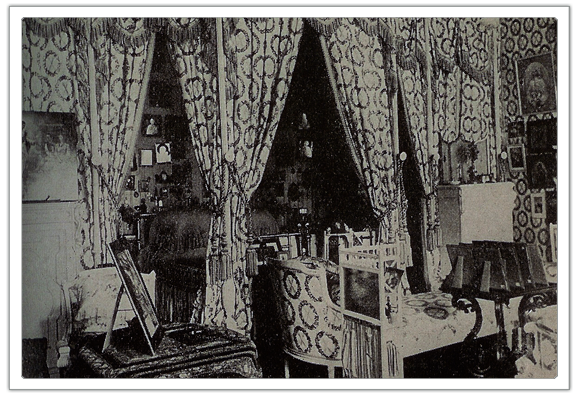
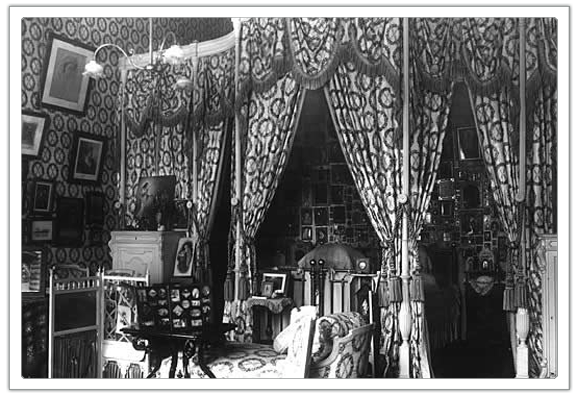
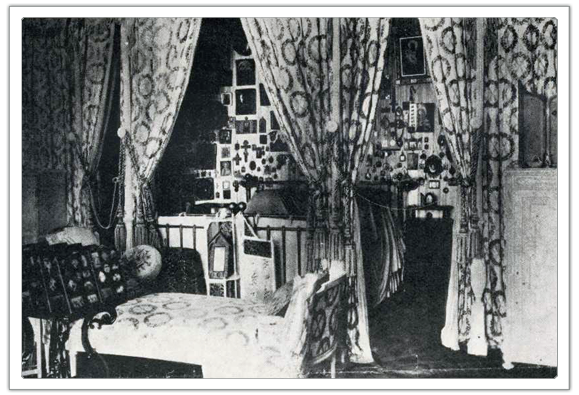
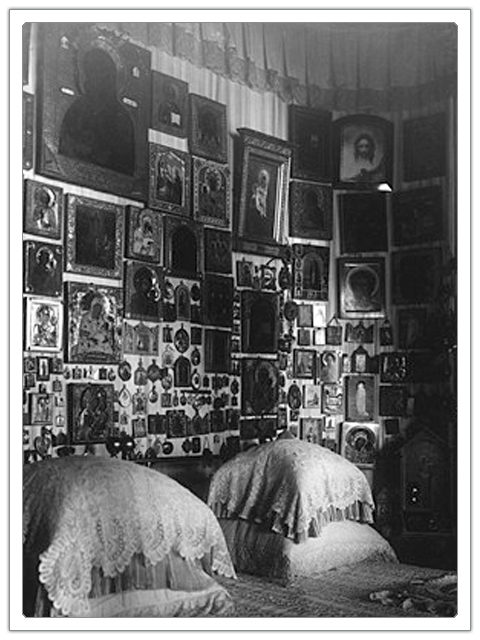
These are all of Alexandra’s Ikons above their bed. A few of these ikons still exist and are now lined on two walls of the room currently (as you’ll see later)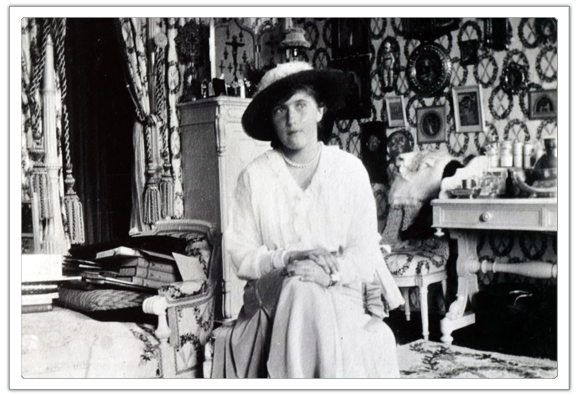
This is the infamous Anastasia sitting inside of her parents room.Now here is the Imperial Bedroom in the current condition today:
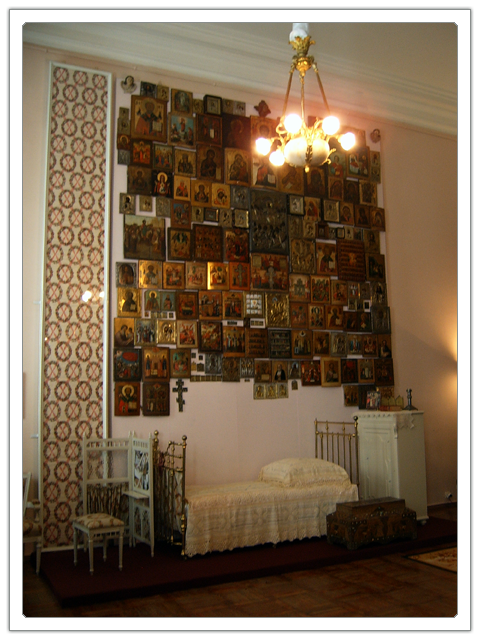

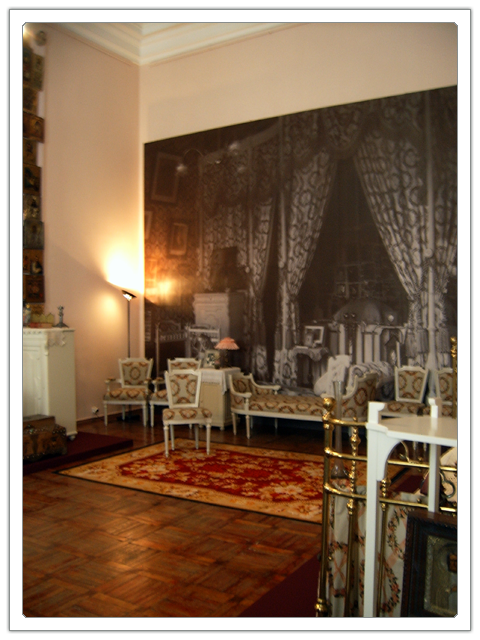



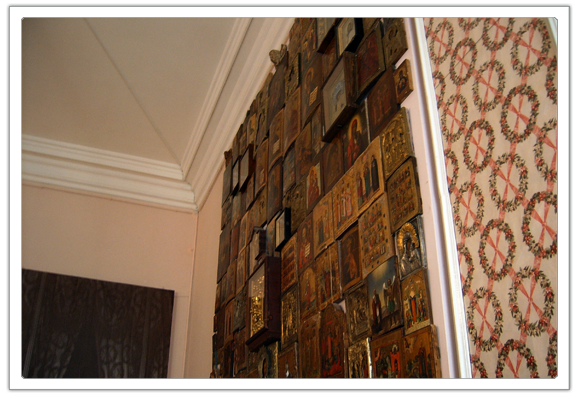
And… of course, here is two videos:
The Mauve Room
Right after the Imperial Bedroom comes Alexandra’s Mauve Room. This room was designed for Alexandra shortly after she married Nicholas and it was used mainly as a family room for the years the Romanovs lived there. It was a common spot where Alexandra would lie down to write letters, do handiwork (sewing, knitting, etc).
Here is the Mauve Room in the Romanov’s time:
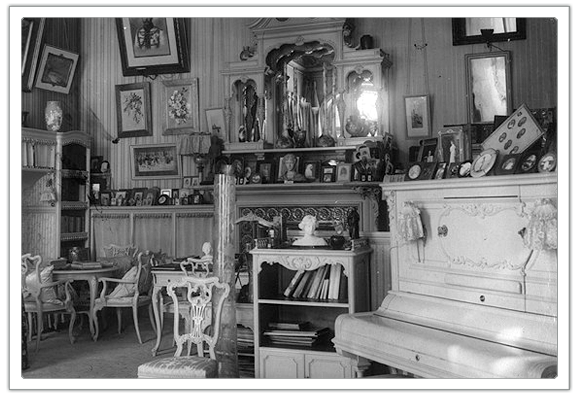
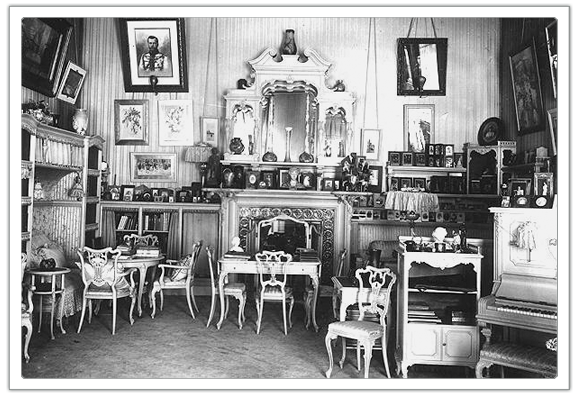
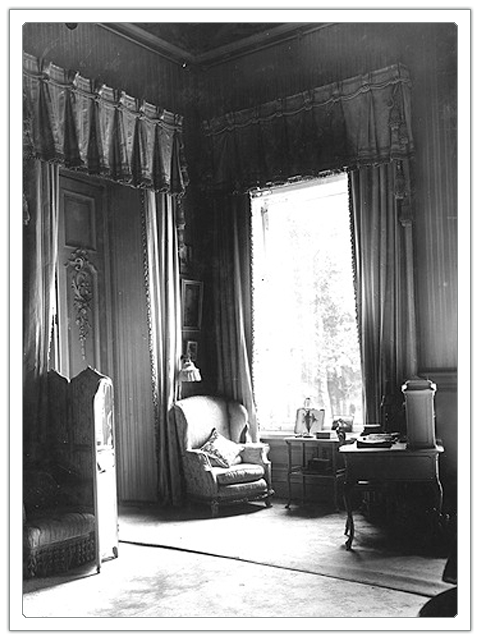
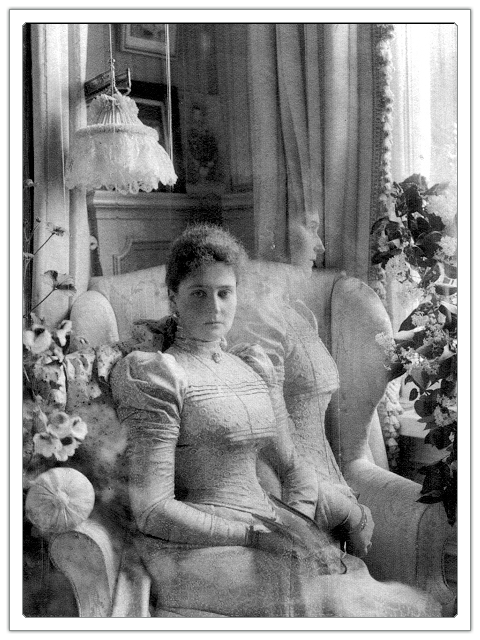
Alexandra in an accidental over-exposed photograph, sitting in the Mauve Room.
Another stunning image of the Empress Alexandra in the Mauve Room. This last one was Coloured by Ms. Lisa Aubry.Here is what the Mauve Room looks like today:
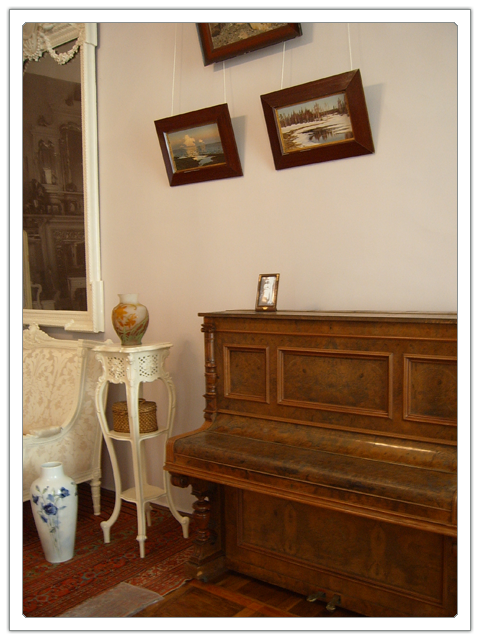
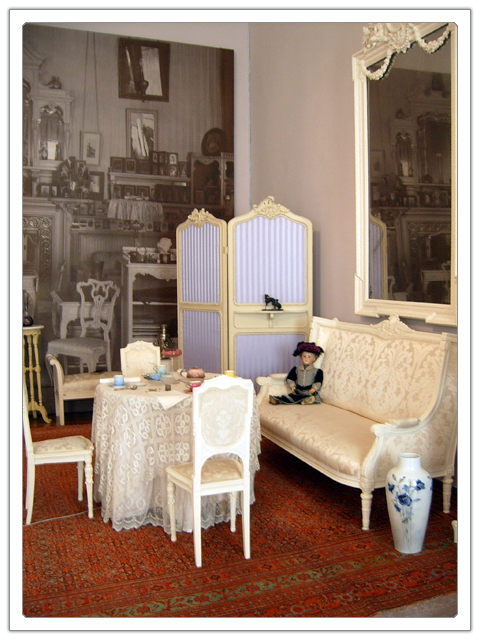
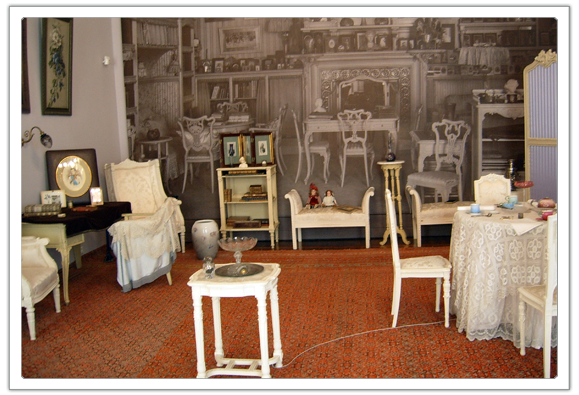
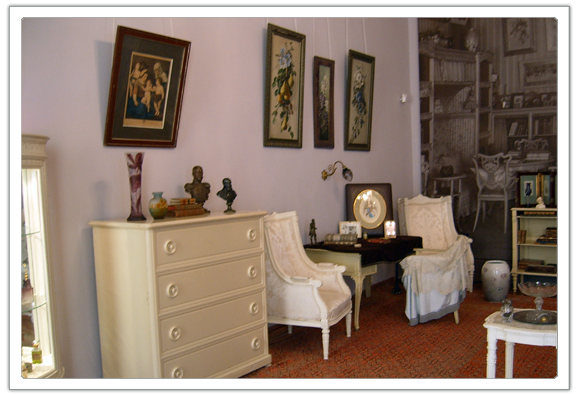
And of course, here is a video:
Pallisander Drawing Room
After the Mauve Room, we come to the Pallisander Drawing Room. This room was the primary sitting room for Nicholas and Alexandra during their first years in the palace. Throughout their reign this was kept as part of the private wing of Nicholas, Alexandra and family.Here is photos of the Pallisander Drawing Room in the Romanovs time:
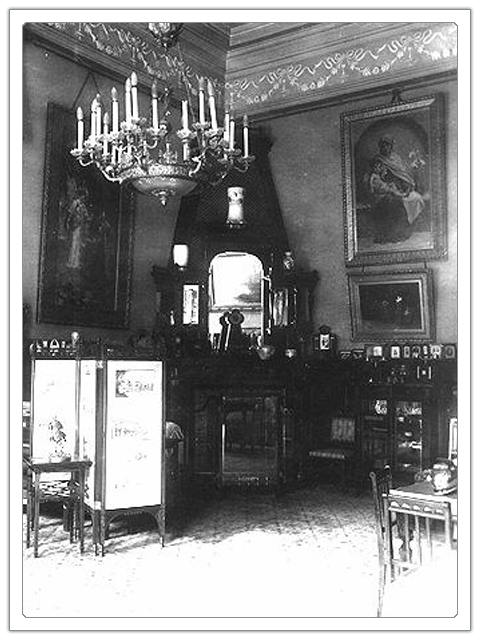
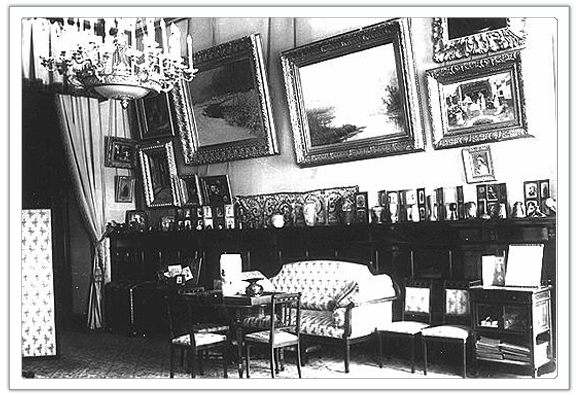
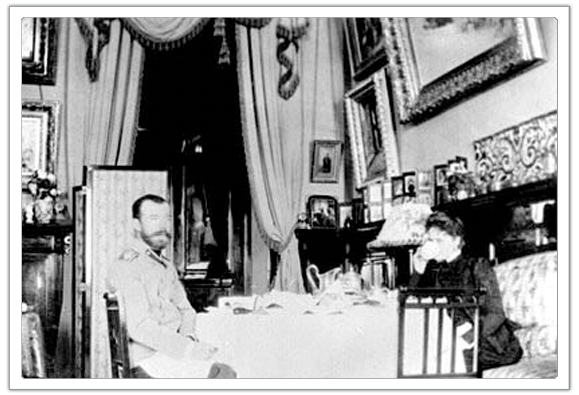
And here it is currently:
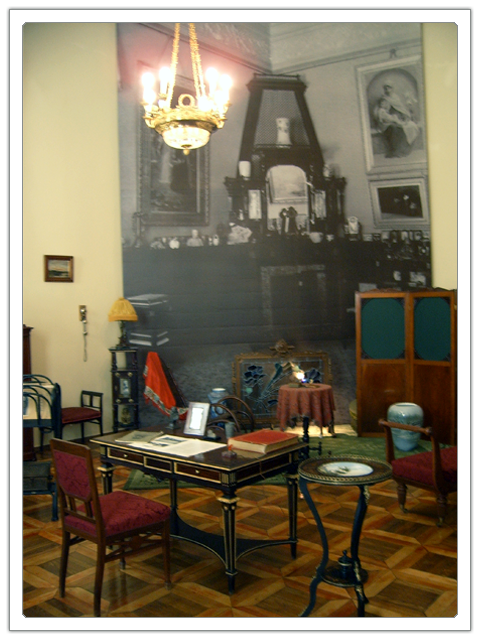

And Video:
The Maple Drawing Room
This next room gets my blood boiling. During the Nicholas and Alexandra’s occupation of the palace, this room was one of the most stunning. Beautifully designed by Roman Meltzer with Alexandra’s oversee, this room was two levels. On top, there was a children’s room to play or sit, and below would be a sitting area. It honestly was stunning. “The walls were painted a warm dusty pink. Ornamenting the walls were carved and moulded white-plaster trellises of German cabbage roses which climbed and entwined themselves about a pale green circle set in the center of a high ceiling”(source). So, without further ado:
Here are images of the room, Romanov era:

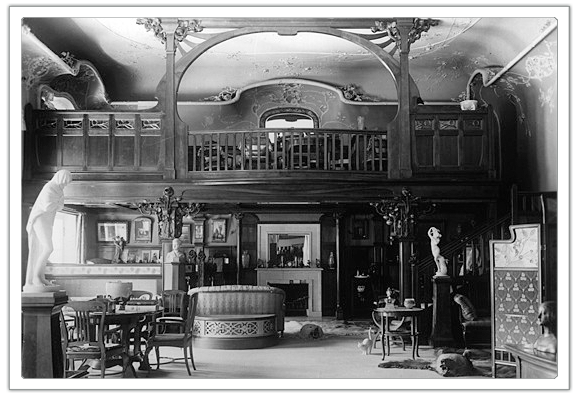
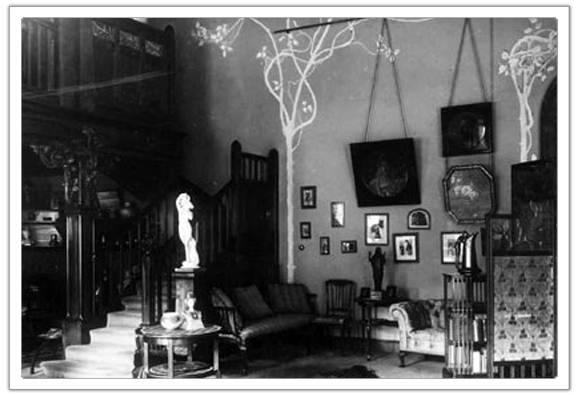

This last one is a close-up of the details that could be seen on the walls. It honesty looks stunning. *sigh*This room, remarkably, survived WWII (and Nazi occupation). But sadly, it would not survive Stalin. It was ripped apart, stripped and split into two rooms between 1947 and 1951. Not sure when, but this is what it looks like now:
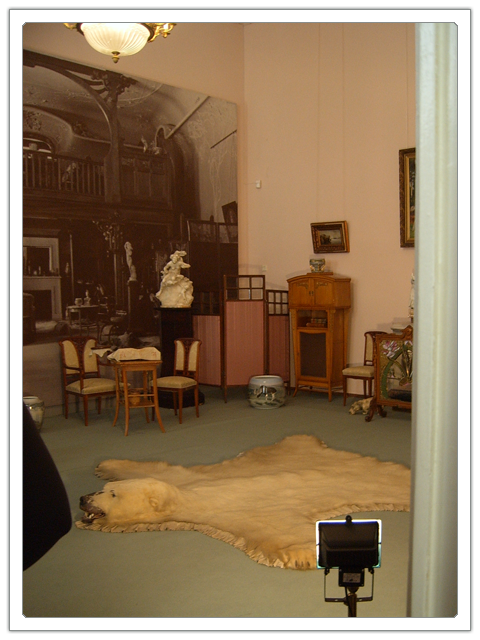
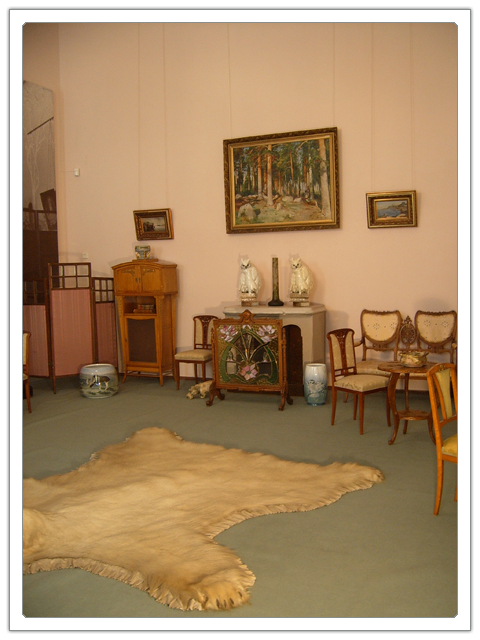
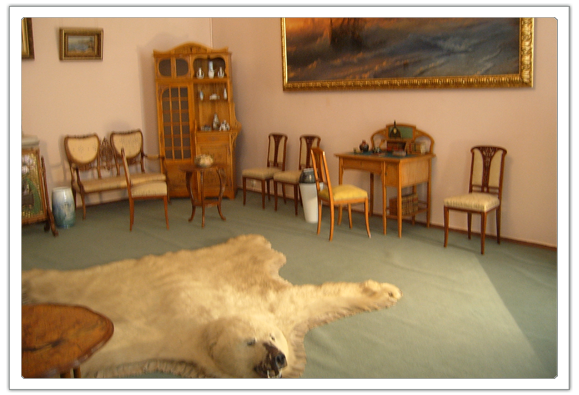
Video:
……
I have nothing more to say on the condition of this room currently. Such a shame.The Maple Drawing Room (Part Two)
So this next room used to be apart of the old Maple Drawing Room, but a wall has since been put in here, and it now holds the suits of the Tsarevich Alexei, as well as some things from his room. Along side these items are some toys of the children and Tatiana’s regiment suit: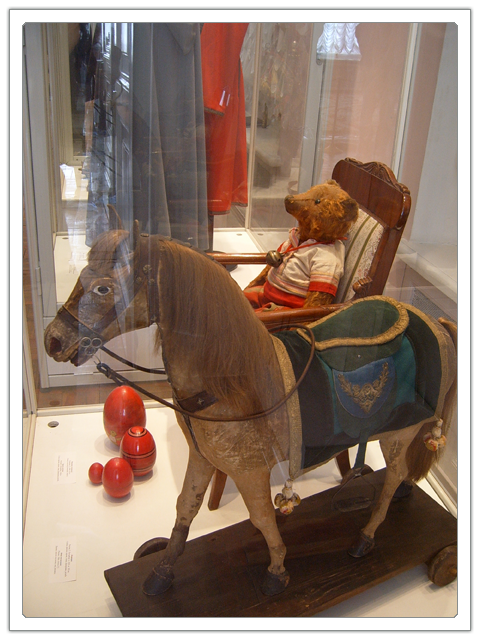
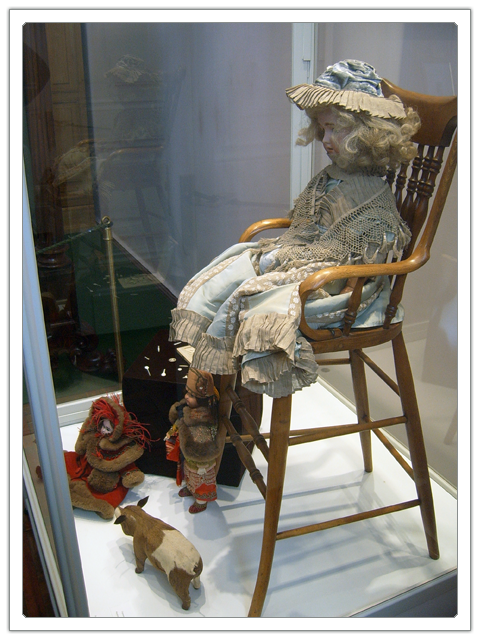
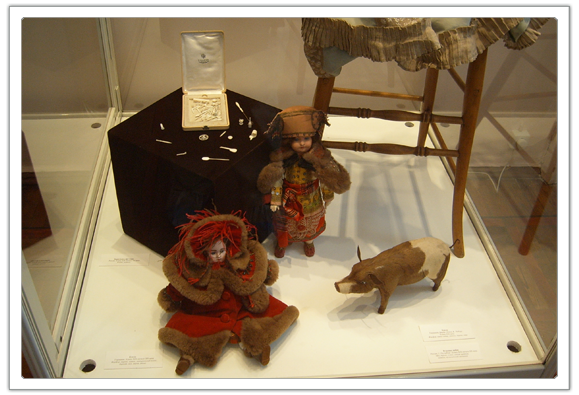

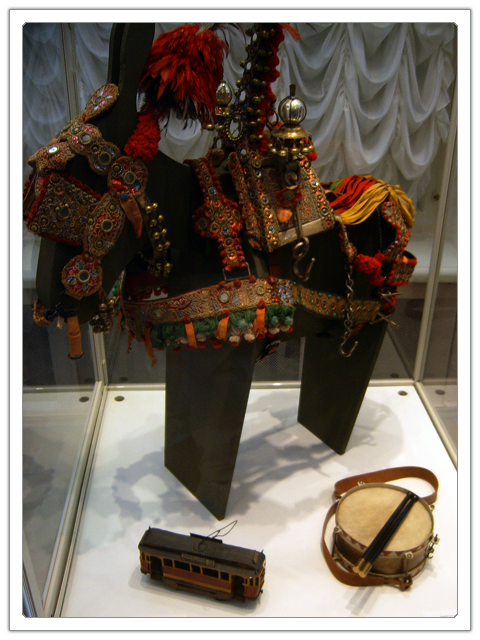
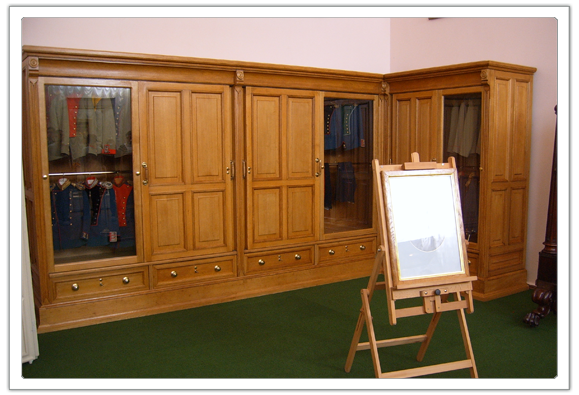
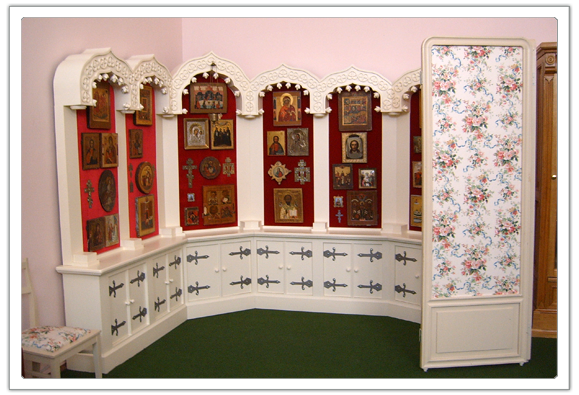

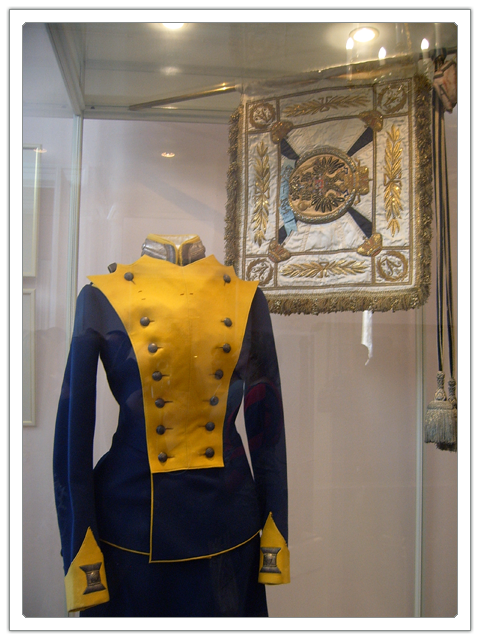
Tatiana’s Regiment Dress. (As can be seen here – She’s on the right.)
and a video:
Alexandra’s Formal Reception Room
The largest personal room belonging to the Romanovs. In the 1900s, Alexandra had the room redecorated with a combination of 18th Century furniture and items. This was also where Alexandra would receive ministers, ambassadors and deputies. The Imperial Family participated in concerts that were also held in this room. The interior was heavily damaged during WWII and restored in 1947-51. At that time a new doorway leading to the left wing of the palace was built.Pictures during the Romanov’s occupation:
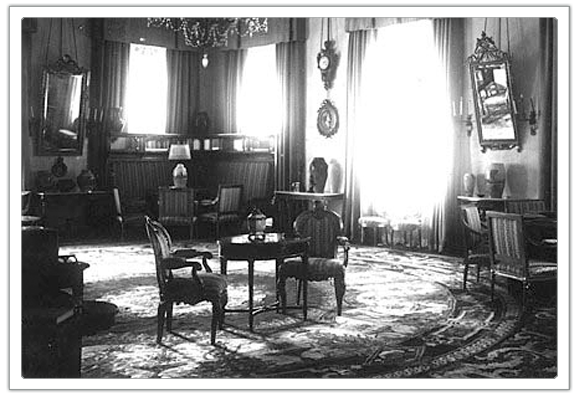
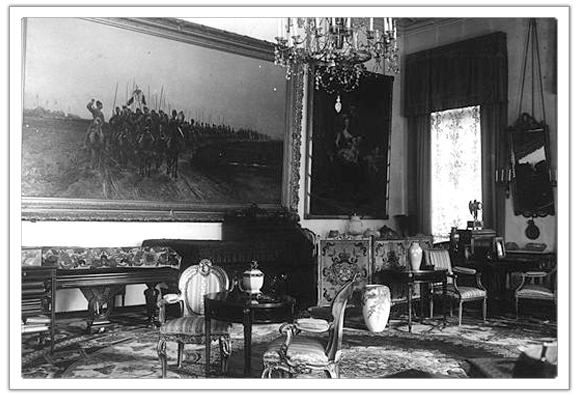

Here is Nicholas II and Alexandra’s beautiful daughters. From left to right: Olga, Tatiana, Maria, Anastasia.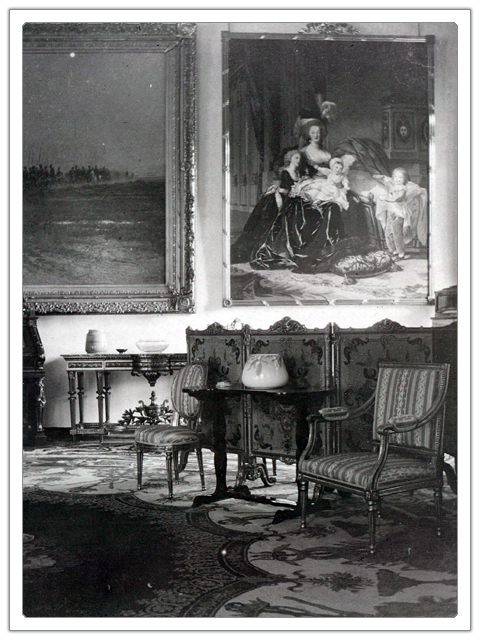
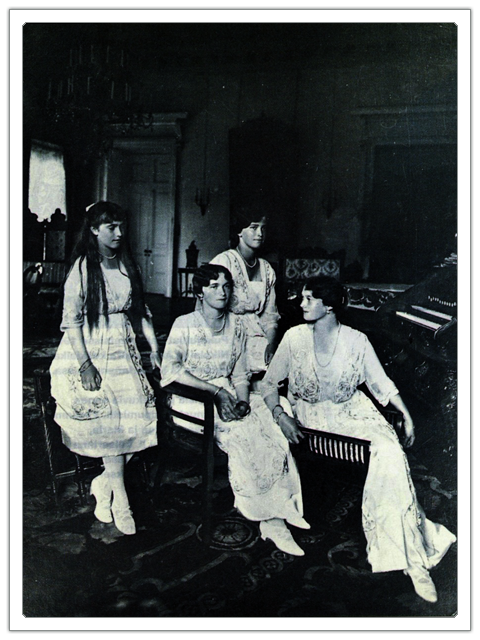
The Grand Duchesses again, Left to Right: Anastasia, Olga, Maria, Tatiana.And here it is currently:
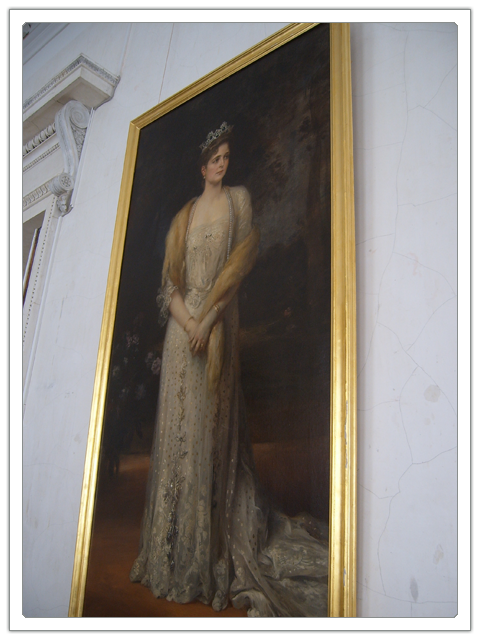
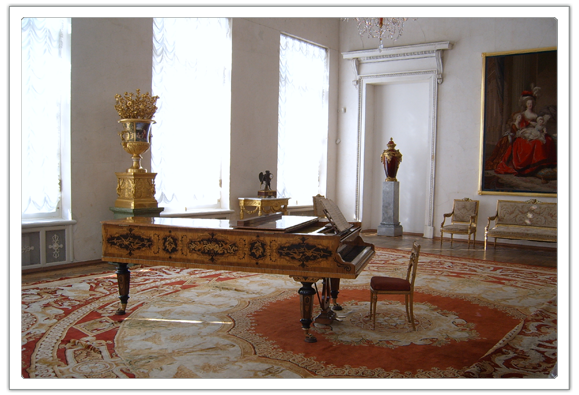
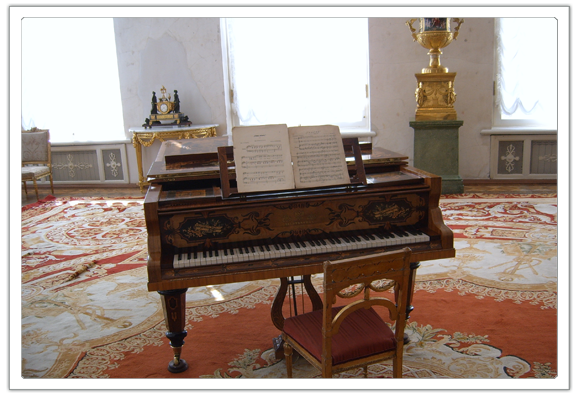
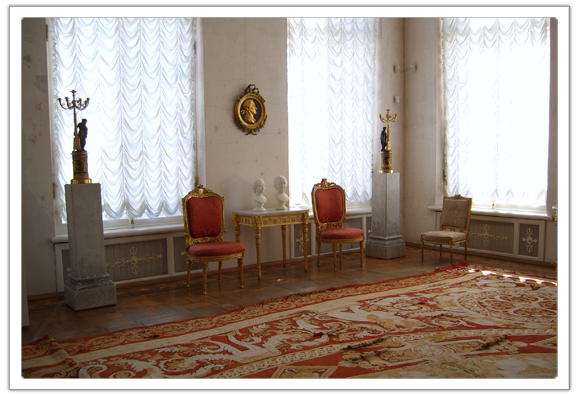
…. to be continued……
 votre commentaire
votre commentaire Suivre le flux RSS des articles de cette rubrique
Suivre le flux RSS des articles de cette rubrique Suivre le flux RSS des commentaires de cette rubrique
Suivre le flux RSS des commentaires de cette rubrique
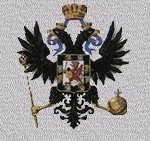

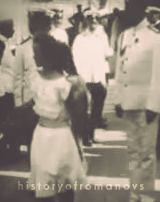
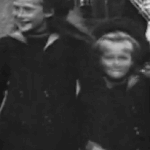
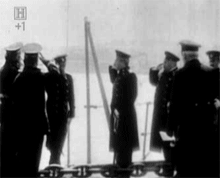

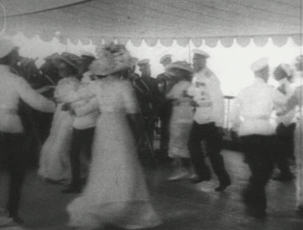




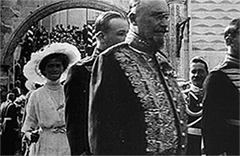 nos
nos




